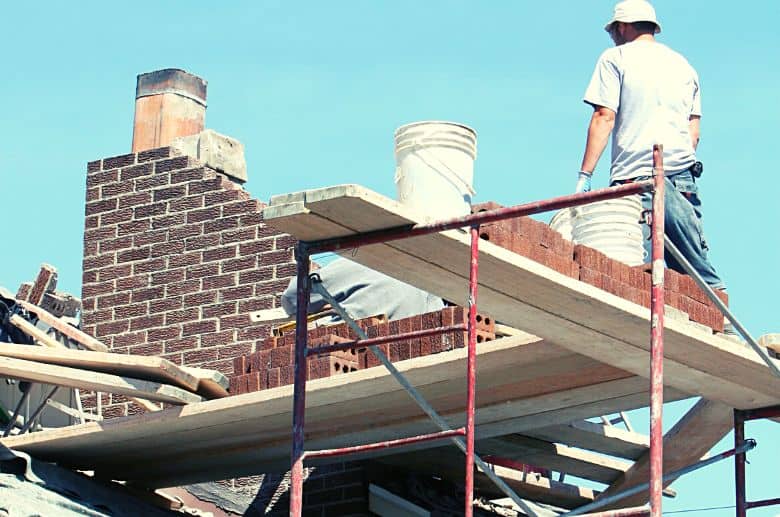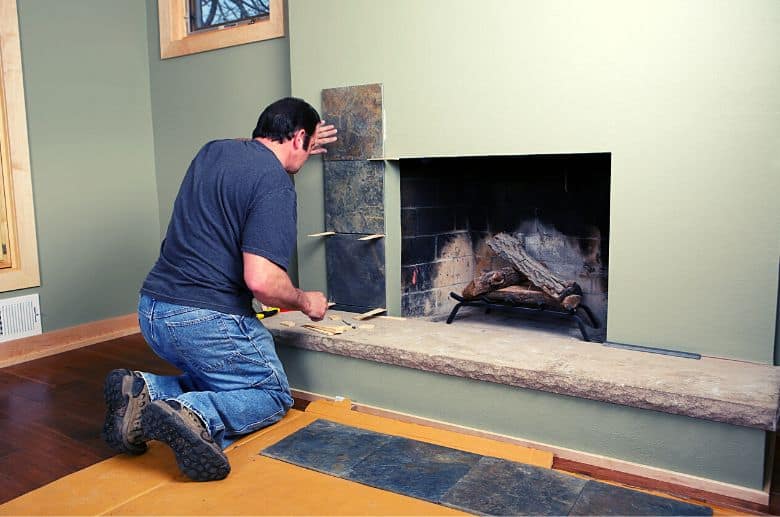A brick chimney is an important part of a home. Over time, the brick and mortar of your chimney deteriorate because of exposure to elements such as rain and snow.
A damaged chimney won’t exhaust smoke from the fireplace properly, and the damage can affect the structural integrity of your home.
If you don’t fix your chimney as soon as you notice a problem, you will eventually pay thousands of dollars to rebuild it. That is why chimney restoration is crucial.
In this guide, we will discuss the common signs of a damaged chimney and the benefits of chimney restoration.
What is chimney restoration?

Chimney restoration means fixing the damaged parts of your chimney. The chimney is the highest point of a house, so it is exposed to elements such as rainwater, snow, and wind.
These elements cause the chimney parts to wear out. This can include the brick and mortar, chimney crown, flue liner, and firebox.
The restoration process depends on the affected component. For example, if there are cracks in the firebox, refractory mortar can be applied to seal them.
Note that chimney restoration isn’t the same as a total rebuild. A chimney rebuild entails replacing the brick and mortar as well as the crown. We recommend rebuilding your chimney if the damage is extensive.
Signs that your chimney may need restoration work
Discovering that a chimney needs restoration work can be challenging for many homeowners and lead to many questions. Luckily, there are obvious signs to look for that might help you catch chimney damage faster.
Brick and mortar Damage

Brick and mortar damage is a common sign of chimney deterioration. The mortar holds the brick together and ensures the stack is firm. Common signs of damaged mortar are cracks and gaps between the bricks.
Bricks are porous. That means that rainwater, melted ice, and snow melt over time can seep into the bricks and lead to spalling. This is where the bricks crack and pieces fall, potentially damaging your shingles, roof, and even putting the safety of those on the ground at risk
It usually happens during the freeze-and-thaw cycle and is common in chimneys that have been around for decades or aren’t regularly maintained.
When these issues become apparent, chimney resurfacing is a crucial procedure to consider. This process involves repairing or replacing the outer layer of brick and mortar to restore the chimney’s structural integrity and appearance.
Other signs of damage include missing bricks and large spaces between them. If you notice these signs, contact a qualified chimney sweep to do an inspection and fix the damage.
——
Do You Need to Hire Chimney & Fireplace Expert?
Get free quotes from qualified experts near you. No commitment required!
——
Broken Chimney Liner

The chimney liner exhausts combustion byproducts like smoke and gases like carbon monoxide.
If water is seeping into your chimney, it will weaken the liner. If you see flue tile pieces in the fireplace, your liner is damaged.
If the liner is broken, your chimney will be inefficient, and you will face problems such as backdrafts. This will make it challenging to start or maintain a fire.
Cracked or broken chimney crown
The chimney crown covers the top of your chimney. It is a crucial component that prevents rain and snow from entering.
It also keeps animals away, preventing them from wreaking havoc in your chimney. Like brick and mortar, the crown deteriorates over time.If you notice small cracks, you can seal them. But if the gaps are too big, we recommend replacing the chimney crown.
Chimney Foundation Issues
Here are two main reasons your chimney can have foundation issues. Let’s take a look at them.
- Water damage – Water is the number one enemy of a masonry chimney. Water can easily seep into the chimney structure when the brick and mortar deteriorate. Over time, the water moves to the foundation and weakens it. One of the obvious signs of foundation issues is a leaning or tilting chimney.
- Improper construction – You may face foundation issues after a few years if your chimney is not built properly. If you want to build or rebuild your chimney, always use an experienced chimney sweep.
What does a chimney restoration company do?
A chimney restoration company fixes the damage on your chimney to ensure it functions well. If you don’t repair your chimney as soon as you see a problem, you will eventually pay high costs to do extensive repairs or rebuild it.
A chimney restoration company provides the following services:
Chimney Refacing
Chimney refacing means repairing or renewing your brick-and-mortar chimney’s “face” or surface. Chimney refacing comprises the following repairs:
Masonry chimney repair

Spalling bricks allow more moisture into the chimney. Applying caulking to the small cracks on the bricks prevents water from seeping into the bricks and causing further damage.
In situations where the cracks are too big, caulk will not help. In these cases, brick chimney restoration companies will remove and replace damaged chimneys.
This reconstruction is not a simple DIY job. Always leave the replacement of bricks to skilled chimney sweeps. Common signs of mortar deterioration include cracks, flaking, and discoloration.
Tuckpointing is a process that involves replacing old mortar with new. Replacing these mortar joints ensures water doesn’t get into your chimney.
——
Do You Need to Hire Chimney & Fireplace Expert?
Get free quotes from qualified experts near you. No commitment required!
——
Chimney crown repair
The chimney crown should also be well-maintained. Small cracks on the crown can be fixed by applying a waterproof sealant. If the cracks are large, you should replace the crown.
Chimney flashing repair
The chimney flashing is found where the roof meets the chimney stack. It is typically waterproof to prevent rainwater from seeping into the bricks.
A flashing sealant will fix the flashing if it is loose or cracked. And if the cracks are too big or large parts of the flashing are missing, replacing it is the best option.
Chimney cap replacement

The chimney cap covers the top of the flue and prevents water, debris, and animals like birds and squirrels from entering your chimney.
If missing or damaged, it will allow water to enter your chimney and damage the flue liner, damper, and firebox.
Replacing a broken chimney cap ensures chimney components are protected. The chimney caps need to be of the appropriate size and should be installed properly to avoid issues in the future.
Chimney relining
Your chimney liner will require relining if it is cracked. The chimney liner insulates your chimney and allows the movement of smoke and fumes up the chimney and out of your home.
Chimney relining involves replacing your current flue liner. You can replace it with the following:
- Metal chimney liners made of materials like stainless steel
- Clay flue liners
- Poured-in-place chimney liners
Fireplace Restoration
Don’t forget the fireplace as you restore parts of your chimney, like the brick and mortar, chimney crown, and flashing. Let’s discuss repairing fireplaces.
Firebox repair

Many years of extreme heat and water leaking through your chimney can take a toll on your firebox.
Firebox cracks allow smoke and dangerous gases like carbon monoxide to enter your home. Carbon monoxide causes issues like vomiting and dizziness. Serious carbon monoxide penetration can even result in death.
You can seal firebox cracks by applying refractory caulk.
Fireplace mantle repair
The mantel is a decorative piece that makes your fireplace visually appealing. Mantles contract and expand because of the fireplace heat. This leads to cracks and splits. Repairs include replacing and tightening screws and applying resin glue (on hardwood mantels).
Your local chimney sweep will advise on how to repair your chimney mantel.
Damper repair
The damper is located in the chimney flue. It allows smoke to exit your chimney.
It is usually closed when not in use to prevent cold air from entering your home through the chimney. Damper issues include bad positioning, damage, and not opening or closing.
A certified chimney sweep will help you fix any of these problems.
Smoke chamber parging
The smoke chamber is the opening above the firebox, leading smoke and fumes into the flue. The bricks in the smoke chamber wear out eventually and fail to create a smooth path for the smoke and gases to move up the flue.
Soot stains on top of the firebox and smoke flowing back into your home are indications that your smoke chamber requires parking.
Refractory mortar is used to fix the deteriorating bricks and smooth the walls of the smoke chamber. Smoke chamber parging is best done by a professional chimney sweep.
——
Do You Need to Hire Chimney & Fireplace Expert?
Get free quotes from qualified experts near you. No commitment required!
——
Does chimney restoration make a difference?
Chimney restoration is vital as it enables your chimney to function efficiently. It also prevents damage to your home, as the chimney is a major structural component.
The benefits of restoring your chimney include the following:
Aesthetic appeal – A chimney that looks great makes your house more attractive. No one will admire a chimney with spalling bricks, cracked mortar, and a damaged crown.
Add value to your home – Homes with a working chimney usually sell for higher prices than those without.
Safer to use – A chimney that’s in excellent condition will not allow smoke to get back into your home. This way, you will protect your loved ones from carbon monoxide poisoning.
Improve efficiency – A chimney without any damage will function well. You will not experience difficulty starting or maintaining a fire.
Improve chimney draft – Problems like cracked chimney liners usually cause downdrafts. Fixing these issues prevents draft issues.
How do you restore a chimney?
Chimney restoration is not a DIY project. You need to use the services of a professional. A specialist in this field brings not only their extensive experience but also a thorough understanding of the necessary repairs and maintenance.
They are adept at identifying and resolving a wide range of issues, from minor cracks to significant structural damage, and will ensure that all work complies with the building codes specific to your locality. By doing so, they guarantee that your chimney is restored to its optimal condition, both safely and effectively.
Chimney restoration cost
On average, restoring your chimney costs $1,000-$3,000. If your chimney is large or has a complex design, the price can reach $5,000. If the damage is extensive and you must tear down the chimney and rebuild it, you will pay around $10,000-$12,000.
Conclusion
The chimney is an important component of your home. It adds value to your home, keeps it warm, and makes it visually appealing. Chimney restoration ensures it is in perfect condition and functions well. Contact a certified chimney sweep if you need chimney and fireplace restoration services.






